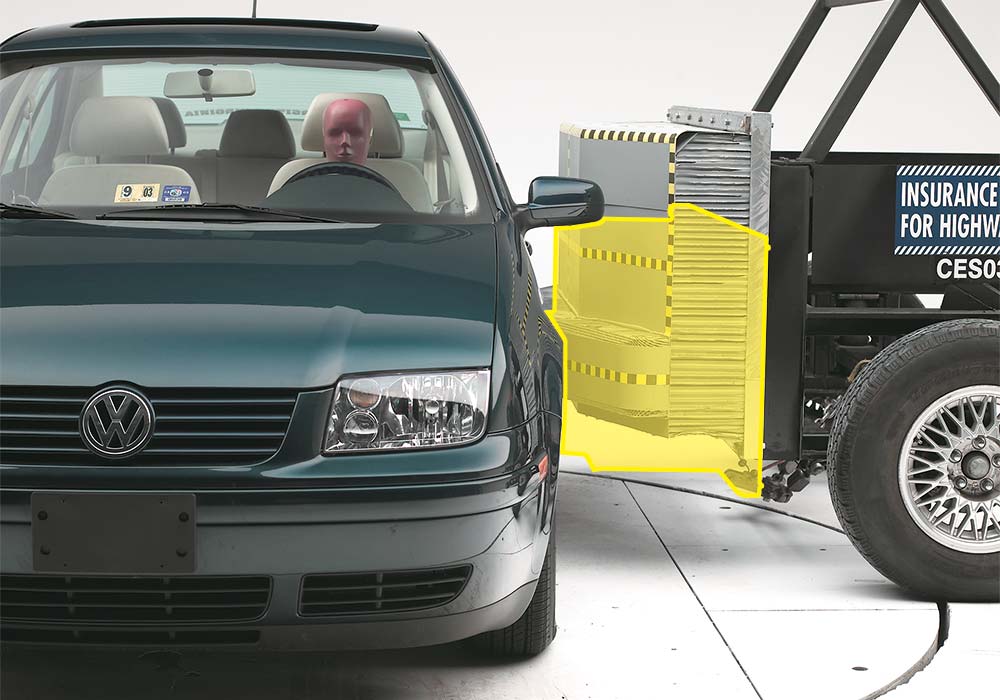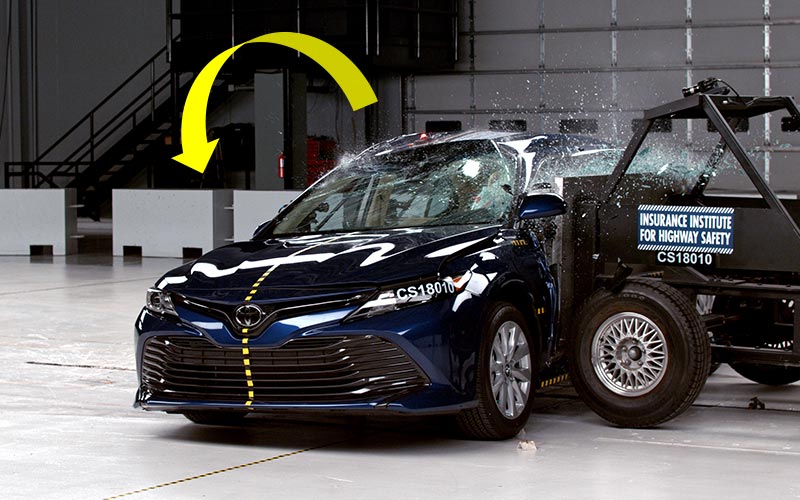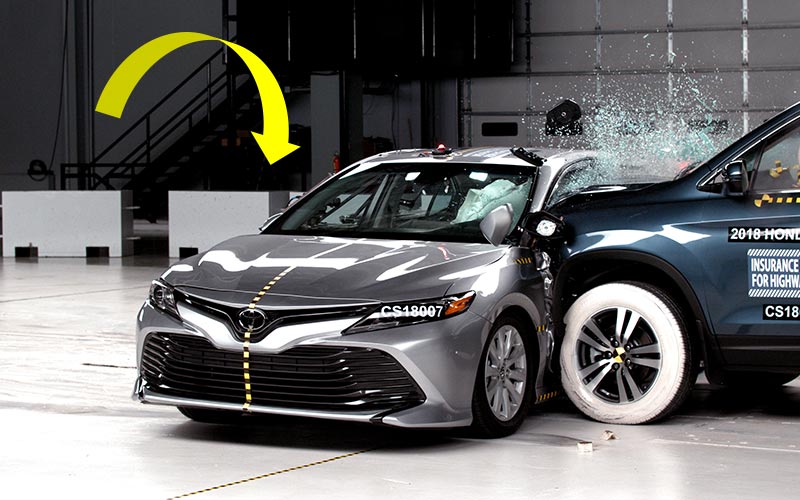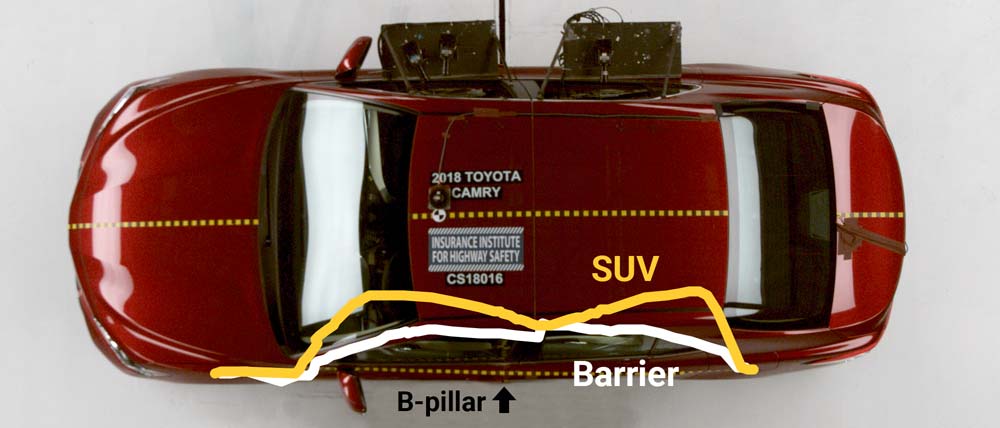IIHS prepares to launch new, more challenging side crash test
November 21, 2019

The Insurance Institute for Highway Safety's side crash test has led to lifesaving improvements in occupant protection since it was introduced in 2003. There's just one problem: The program has been so successful that the current side ratings no longer help consumers distinguish among vehicles or point the way toward further improvements.
An updated test should help. IIHS researchers and engineers have been weighing potential changes. A new test program with a higher impact speed and a heavier, more realistic movable barrier representing a more modern striking vehicle is expected to be launched next year.
In addition to identifying things that should change, the research has also clarified what aspects of the current evaluation work well. Measures collected from the test were found to correlate closely with fatality risk. Thus, the new test will likely use the same dummies and collect similar information as the current one.
"This is an opportunity to build on what we've learned in more than 15 years of side testing," says IIHS Senior Research Engineer Becky Mueller. "We'll update the things that need updating, but we don't need to throw out the things that still work well."
Crash test history
When IIHS developed its current side crash test, it filled a need that had emerged with the rise in popularity of SUVs. At the time, the National Highway Traffic Safety Administration (NHTSA) was conducting side tests as part of its consumer information program, using a movable barrier with the height of a car. That test, still part of NHTSA's ratings, doesn't reflect the much greater risk of head injury from impacts with taller vehicles.
The IIHS test proved more challenging than the NHTSA test because the movable barrier mimicked the height and shape of the front end of the typical SUV or pickup on the road at the time. IIHS also used dummies representing a small woman or 12-year-old child. The combination of these two things meant that the barrier struck the vehicle at about the height of the dummies' heads.

To achieve a good rating in the test, automakers strengthened side structures and equipped vehicles with head-protecting side airbags ahead of a federal regulation that made them essentially mandatory. Only about 1 in 5 vehicles tested earned good ratings in the beginning. Today, 99 percent of rated vehicles earn a good rating, and the remainder are acceptable.
The improvements translated into lives saved. A 2011 study of 10 years' worth of crash data found that a driver of a vehicle rated good is 70 percent less likely to die in a left-side crash than a driver of a vehicle rated poor.
But despite overwhelmingly good ratings for today's vehicles, people continue to die in side crashes. Side impacts accounted for 23 percent of passenger vehicle occupant deaths in 2018.
Comparing rating criteria to real-world outcomes
One question is whether the current side test measures the right things. To answer it, IIHS researchers conducted another study of real-world side crashes. This time they examined how well each of the test measurements that feed into the ratings correlates with death risk.
The study included 1999-2016 model year passenger vehicles with standard head-protecting side airbags that had been rated by IIHS for side protection. The researchers looked at the rate of driver deaths per left-side crashes for each model. They compared these rates with 10 specific intrusion and dummy injury measures that go into the ratings, finding that each one was correlated with driver death risk in left-side crashes.
For example, the authors estimated that each additional centimeter of B-pillar intrusion was associated with a 3 percent increase in death risk. Each additional millimeter of rib deflection, one of the measures recorded by the dummies in the test, was associated with a 1 percent increase in death risk.
"This tells us that the current side crash test measures the right things," says IIHS Senior Statistician Eric Teoh, the lead author of the paper. "We know that we don't need to go in a completely different direction or upgrade to expensive new dummies as we update the test."
Optimizing test conditions
An earlier IIHS study looked at side crashes in good-rated vehicles that resulted in deaths or serious injuries. That study showed that many of those crashes were more severe than the IIHS test and also had a more forward impact location.
The severity of a side crash depends on both the weight of the striking vehicle and its speed. The movable barrier currently used in the IIHS side test weighs 3,300 pounds. At the time the test began, many SUVs on the road were close to that weight, but they have gotten much heavier since then.
To better reflect the higher-severity crashes occurring in the real world, Mueller and other IIHS engineers began a series of research tests at a higher speed — 37 mph instead of the 31 mph speed used in the current side rating test. They also made the movable barrier heavier, increasing its weight to nearly 4,200 pounds, the average weight of a 2019 model SUV.
"These changes might not sound like a big deal, but the 6 mph speed increase alone produces 42 percent more crash energy," Mueller says. "Together with the weight increase, the modified test configuration has 82 percent more energy than our current side rating test."
IIHS engineers also conducted tests with a more forward impact location on the struck vehicle, but that change didn't appear to lead to higher injury risk. In fact, the injury measures from the dummies were lower in the forward configuration than in the standard configuration.
The goal of these research tests was to see how well crashes at the higher speed with the heavier barrier resembled crashes using a real SUV or pickup in place of the barrier.
For the initial round, the team selected four good-rated vehicles — a Toyota Camry, Volkswagen Atlas, Honda Accord and Infiniti QX50 — to subject to a variety of impacts. The test vehicles were struck by a popular pickup, SUV and car, as well as by the 4,200-pound movable barrier. Tests were conducted at the current side test speed of 31 mph and also at 37 mph.
The crashes with the movable barrier weren't identical to the crashes with a second vehicle. Video footage showed that the struck vehicles rolled away from the barrier but toward the striking vehicles.


The structural damage also differed. The striking vehicles' frame rails — the stiffest part of a vehicle front — punched into the middle of the struck vehicles' doors, wrapping around the B-pillar.
In contrast, the movable barrier has uniform stiffness and strikes the vehicles more evenly. That means the B-pillar can absorb more of the crash energy in the test than it would in a real-world crash.

The engineers are now experimenting with changes to the barrier's honeycomb face to try to better replicate the interaction of vehicles in a real-world crash involving a late-model SUV or pickup as the striking vehicle. They are altering the honeycomb shape and varying the stiffness within it, just as it varies on the front of a real SUV.
"Our goal is to create a barrier that creates the same type of damage as a typical late-model SUV or pickup would in a 37 mph crash," Mueller says. "That way, we can be confident that the changes automakers make in hopes of achieving good ratings in the new side test will result in better protection for vehicle occupants in real-world crashes."